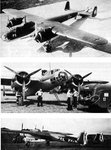Matt308
Glock Perfection
As many of you know the self sealing fuel tank was quite a leap in technology in the early last century. I have a couple of questions.
1) Who (person/country/company/etc) invented self sealing fuel tanks?
2) When?
3) In what airplane were they first installed?
4) Can you describe the technology used?
Here is what spawned my question. I do know that the Germans made use of self sealing fuel tanks in Do17s during the BoB. The fuel tanks were surrounded by a 1cm liner that consisted of alternating layers of vulcanized and non-vulcanized rubber. The final outer layer was actually leather. Apparently, a rifle round would penetrate this outer 1cm thick liner and the resultant fuel leak would set up a chemical reaction that would literally melt the rubber back together. I am assuming the leather was an expedient means of containing the inner layers and prohibiting a "runaway" chemical reaction.
The above questions are hopefully going to stimulate some discussion of the origin of self sealing techniques and where they originated from.

1) Who (person/country/company/etc) invented self sealing fuel tanks?
2) When?
3) In what airplane were they first installed?
4) Can you describe the technology used?
Here is what spawned my question. I do know that the Germans made use of self sealing fuel tanks in Do17s during the BoB. The fuel tanks were surrounded by a 1cm liner that consisted of alternating layers of vulcanized and non-vulcanized rubber. The final outer layer was actually leather. Apparently, a rifle round would penetrate this outer 1cm thick liner and the resultant fuel leak would set up a chemical reaction that would literally melt the rubber back together. I am assuming the leather was an expedient means of containing the inner layers and prohibiting a "runaway" chemical reaction.
The above questions are hopefully going to stimulate some discussion of the origin of self sealing techniques and where they originated from.

